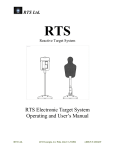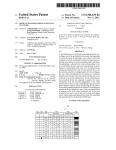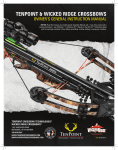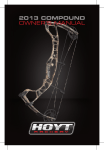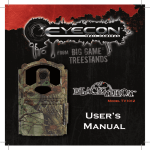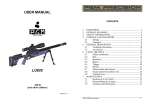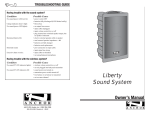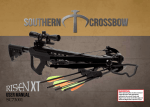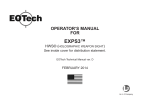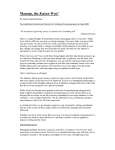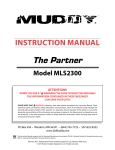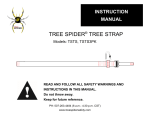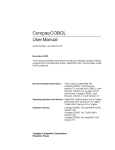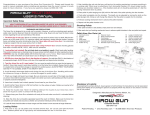Download Nov 2012 - Siege 330 Crossbow Test
Transcript
By Jon Teater Siege 330 Built by Middleton Crossbows, Marketed by Bohning A s mentioned in the September edition of ArrowTrade, The Bohning Company, Ltd. has teamed up with Middleton Crossbows to deliver a new line of crossbows known as the Siege. Middleton is a small company just outside of Toronto, Canada, run by Derrick Middleton. Middleton has produced crossbows for several years but lacked that marketing edge that most companies need to make significant sales in this industry. Bohning possesses the pivotal skills of sales, distribution and marketing. With their respective strengths in mind, Middleton and Bohning have combined their talents. Derrick Middleton has developed a strong following over the past few years. Most of the supporters are diehard recurve crossbow users. From an outside perspective, I really see crossbow users either totally liking recurve crossbows or not at all. The Siege was designed to change the like-it or hateit mind-set of many crossbow users. Rick Mowery, Bohning Advertising Director, believes the Siege will draw more archers toward the lightweight reliability of recurve-style crossbows. The Siege is offered in four models: the 315, the 330, the 355 and the 375. As the model number increases, so does the “power.” The power is created by the PurePower Recurve Limb Technology. The limbs are created for performance and to get there, they store a lot of energy. The front ends of the Siege models are all the same; variations in barrel length and ultimately powerstroke create the difference. That variation in powerstroke creates the potential for higher peak draw weight. For example, the Siege 330 is advertised to have a 200 pound peak weight and a 14.5 inch powerstroke. The “lighter” model, the Siege 315, is 180 pounds and has a 13.5 inch powerstroke. The output of either crossbow model is impressive, yet the faster of the two is the 330. But keep in mind: the 375 has an advertised 245 pound draw weight and 16.5 powerstroke, so you can expect some heady speeds. Testing Background The Siege 330 went through a standard and regimented performance test. The focus of this type of test is to determine, for a specified product, the performance characteristics. Additionally, the goal is to provide those archers that enjoy shooting and/or hunting with appropriate objective information, as well as some subjective commentary, to aid in the purchase process. With that said, this evaluation is by no means conclusive. Each archer should assess what is important to him or her and interpret the results within the context of this article. As always, I recommend that anyone who is considering a crossbow shoot as many different makes and models as possible to determine what best suits his or her individual needs and desires. Please note: due to the lack of testing methods and procedures 56 Nov12AT056-61.indd 56 10/11/12 11:33 AM available publicly for crossbows, testing guidelines were developed and published in 2009. These testing guidelines remained unchanged since then and I continue to use these methods to evaluate crossbows. Introduction As mentioned, the Siege is offered in various models. The differences in basic design amongst the models are minimal, though the performance does vary. The choice of the various models is a great benefit to the archer. Each is slightly longer or shorter, creating the perfect sizing options, with corresponding changes in draw weights and speeds. The aspect most archers will focus on is the limbs. The limbs are longer than on your typical compound crossbow, though lighter since no cams or cables are employed. This width could be a deterrent for some, but I think that objection can easily be overcome after looking at the performance numbers. The limbs are the key component of arrow propulsion. The PurePower Limb Technology is designed and advertised to set this product apart from the competition. Middleton claims this design is the ultimate among recurve limbs in performance while offering great reliability. The computer-engineer limb is designed to store more energy and then reroute the stored energy efficiently as the archer pulls the trigger. The results I obtained show very respectable efficiency numbers. Bohning is a big proponent of the recurve style crossbow, which you’d certainly expect since they have teamed with Middleton. The simple appearance, no-nonsense design, and high power levels available are major selling points. The Siege is made with fewer parts as compared to most competitors. Fewer components should equate to less failures. Because of this, the crossbow has the potential to last longer. The archer can benefit tremendously from the easy to use, straightforward design. As with most higher end crossbows, the archer puts his foot through the stirrup, hooks a drawing aid to the string and pulls smoothly back until the string engages in the rocker-style latch. The components do what they do with ease and the archer should not struggle with any step of the sequence, right through squeezing off the shot. With no cams or cables to contend with, the owner can take more responsibility for maintenance steps like replacing a worn string or twisting it to restore the correct brace height. One of the most useful features of the recurve design and trigger setup is the uncocking method. Almost all other manufacturers insist there is no safe way to unload their crossbows other than firing into the ground or a target the hunter has brought along for that purpose. In either case, your customer will want to use a discharge arrow rather than one tipped with a broadhead and if the ground is soft, he or she may have to dig out the buried shaft. With the Siege, instead of firing an arrow into a target to release the string, an archer can remove the arrow and attach the heavy duty rope-style cocking aid, pulling on one handle 57 Nov12AT056-61.indd 57 10/11/12 11:40 AM until the other comes against the string. Then while maintaining constant pressure on the cocking aid with one hand, he or she can release the trigger with the other and let down the string to the brace position. The simple method of uncocking the crossbow is detailed in several steps of the user’s manual and in practice, it’s very simple to perform. The bottom line is that these features increase usability and that helps sales. I recommend you take the time to demonstrate cocking and uncocking and then explain most other crossbows require you to discharge an arrow, sort of like a muzzle loader requires you to fire a shot (and dirty the barrel) at the end of the hunt. The Siege 330 has some other engaging features. The crossbow itself is extremely light weight. I believe it’s one of the lightest I have tested since 2009, which is a very big plus for anyone carrying the product in the field. The other noteworthy features are the ambidextrous automatic engaging safety and thumbhole stock. Note: there are crossbows on the market, recurve and compound, that require you to set the safety in a separate step after cocking. Obviously, a safety that engages automatically offers an extra measure of protection. The Siege crossbows are sold with an illuminated adjustable multiplex scope that can be set for arrow speeds from 225 to 450 feet per second. The crossbow dimensions/weights as measured out of the box appear on page 56. Next, the crossbow went through a thorough inspection. The review focused on the string/cables, eccentrics, limb and limb pockets, rail, stock, butt plate, trigger housing, trigger and trigger guard. After a thorough review of the Siege 330, I found only a few blemishes on the underside of the prod. I was not turned off by the wear because it was a sign that the product had gone through some quality testing at the facility prior to being sent for testing. Other than the mentioned area, the product was flawless. I would rate the product as above average in the workmanship section. Thereafter, I put the product through a 100-150 shot cycling to verify functionality. Some minor testing was performed but the focus was to detect any issues or concerns with the product before starting the actual performance testing. The Siege performed fairly well in this segment. I was pleasantly pleased to see no changes in bolt tension after rechecking all hardware to confirm that nothing loosened during the initial and final testing. There was some wear and tear on the product. The string serving had some noticeable wear, which was caused by contact against the rocker latch in the trigger housing. Also, the string did stretch after the initial 100 shots. I would suspect the stretching was around 1/2 inch or greater. The crossbow was next evaluated on the five criteria outlined below: DETAILED TEST RESULTS Dynamic Efficiency: The dynamic efficiency portion of the test utilizes a Revere Load-Cell controlled by a winch device; the load-cell connects to the crossbow with a cocking aid. The crossbow is mounted in a shooting platform that controls any movement that might be experienced as Force-Draw curves are taken. The stored energy obtained from the Force-Draw curve is used in conjunction with speed measurements to calculate dynamic efficiency. Speed per inch of Powerstroke: Speed measurements were taken with three projectiles. A Pact Chronograph XP and a Competition Electronics ProChrono IR were set in tandem to record results. The average speed measurement was divided by the powerstroke to determine the speed per inch of powerstroke. Noise Output: Sound measurements were recorded with three projectiles. The measurements were averaged and the sound meter was set to take measurements with the A-weighted filter (which mimics the human ear). Trigger Force: The Trigger Force measurements were recorded in pounds and averaged. An Imada Digital Force Gauge was used to determine the peak Trigger Force. Precision Measurements: Precision measurements provide an indication of how close groups were shot together when shooting by hand from a bench rest or other supportive device. Extreme spread is the method used to calculate group size. The Initial Review The Siege 330 was received tightly packaged in an average size box. The scope was individually contained and the limbs/prod was separated from the 58 Nov12AT056-61.indd 58 10/12/12 2:41 PM In the Field: stock inside the box. The prod mounted easily to the stock with two 5/16 inch bolts and countersunk washers. Next, the scope was quickly mounted to the topside of the trigger housing. Overall, the assembly was quick and easy, taking less than 15 minutes. After assembly, I checked through the manual. The manual encompassed safeguards, assembly and operation. This included other information on how to unstring/string the Siege models. At the end of the manual was the warranty information. It’s important to understand the warranty offerings and their application to the customer. I recommend that this information is thoroughly reviewed as there are specific requirements that must be complied with while processing warranty claims. Just prior to the onset of my shooting, I took precise weight measurements of the arrows I received from the manufacturer. The minimal arrow weight for the Siege 330, 355 and 375 is 350 grains. The 315 is capable of accepting a 325 grain arrow. The product comes with Victory Archery X-Bolt arrows weighing roughly 350 grains; this measurement assumes a 100 grain field point or broadhead. I will mention more about the importance of the arrow setup in the field testing. Before drawing the crossbow, be sure to put the safety in the firing position. The mentioned point is essential for the auto-engaging safety to function. Another very important feature that many archers overlook is the foot stirrup, typically the furthermost point of the crossbow in relation to the archer. Because of its location, it can help stabilize the bow at the shot but it can also act as a tuning fork for vibration. The Siege 330 stirrup is designed to counteract the intense vibration with a membrane that is all-encompassing. The membrane and the inner ridges reduce the potential for slippage while drawing. Any crossbow has the potential to injure the user if a muddy boot slips out of the stirrup while the crossbow is being drawn. As hunting season is just on the brink in my area, I have started to really work hard to shoot as much as I can. I had a fair amount of time to shoot this brand new crossbow. At one of my local hunting spots, I have cleared an area to practice various shooting scenarios. I climbed into one of my hunting treestands located just at the edge of the practice area. With two targets positioned at just under 20 yards and two more at approximately 30-40 yards from my treestand, I began to put this product through its paces. When shooting at all distances but especially longer distances (i.e., 40 yards), I am focused on product comfort and control. The thumbhole design is favored by many for both comfort and control. The size and feel of the stock is reassuring, even cozy and should be well received by most archers. Stabilization is another characteristic I need while shooting the longer distances. The longer limbs of the Siege help to reduce the roll you may 59 Nov12AT056-61.indd 59 10/11/12 11:59 AM experience on some crossbows; this is a big plus when trying to shoot upwards/ downwards. Please note that when shooting, you may find that the limbs can limit maneuverability. You need to be aware, especially while in a treestand, of the limbs in relation to the objects that surround you. Allowing one to strike a portion of the tree or treestand as it recoils could damage the crossbow or even injure the shooter. After just a few shots at the various targets scattered about, I was looking at several dead center hits. The Victory arrow seems to be well made and well-matched to the crossbow. I also brought a few other arrows just for practice purposes and I did not see the same consistency that the Victory X-Bolts provided. This crossbow just flat-out shoots and the combination of a good arrow really goes a long way to enhance the accuracy! With shooting aside, the crossbow felt great in my hands. At around 7 pounds outfitted and 6 pounds without a scope, this crossbow just feels light. By just looking at the crossbow, you may suspect that it’s not light. The longer features like the limb and heavier looking forearm can throw off the perception of the actual weight. But these components are actually lighter than most competitors’ products, as is the remainder of components like the stock, trigger housing and prod. If you’ve got a customer that seems to be shying away from picking up a Siege in your store, try handing it to him and saying, “Feel how light this thing is.” As I mentioned, the size makes it appear heavier than it is and that same perception really makes the weight seem light when you do have one in your hands. The Pure Power Scope was one of the game changers with my shooting. I felt that the 1.25-6 X 42mm design proved excellent for light gathering and clarity. The crossbow scope includes a speed dial that changes magnification. The dial ranges from 225-450 feet per second, which is more than adequate for any Siege model. During the finetuning process, I found that I had adequate adjustment in both axes while I shot from the ground. While adjusting the scope, I evaluated the illumination features of the reticle, which can be adjusted to either green or red. An illuminated reticle is very common in the marketplace. I could certainly see the benefits while I was shooting, especially at last light. adequate down pressure against the arrow. As simple as this feature seems, it creates consistency in arrow contact during the firing sequence. A too-weak spring can allow the bolt to slide forward, particularly if you’re leaning forward in a stand. Another feature that is beneficial to the shooter is the threaded metal flat nock on the X-Bolt. The Siege offers a T-shaped arrow puller that screws into the nock, allowing for easy arrow removal. The metal flat nock provides another benefit to the archer. The flat nock reduces the need to precisely index or seat the arrow against the string. This reduces the element of human error in the shooting sequence and results in better precision downrange. Another exciting feature is the trigger. The trigger is very predictable, Hot Features: It’s hard not to talk about the “hot” features without really focusing on what makes this product function. Outside of the robustly designed limbs, there are several features that support precise shooting. The arrow retention spring comes to mind as an initial feature. The spring provides more than 60 Nov12AT056-61.indd 60 10/11/12 12:09 PM and return it to position. I would suggest that specification lines are added to the barrel to show a “preferred” string location while the crossbow is in the static position. The other feature that was poorly rated is the sound. This product is quite loud and produces more sound than many crossbows on the market. With some additional damping devices, the Siege could have some major noise reductions and become even more appealing. I will mention that weight is a major selling point of this crossbow. If the weight is offset significantly because of additional mass due to damping components, some archers may not realize the original benefits in design. Therefore, any design changes should consider this. Overview: as it has a short duration of stacking until reaching a crisp breakpoint. An “unsurprising” breakpoint is essential to consistent shooting. In addition, the trigger possesses a peak weight within the range that most archers consider optimal (3 to 6 pounds). Buyers want their crossbows to be easy to use. Earlier, we talked about how the Siege models can be uncocked, something that’s problematic on other brands. The Chameleon Quiver offered by Bohning has a mount that puts it in line with the crossbow barrel, while most quivers mount crossways under the limbs. This quiver allows for quicker and more convenient access to the arrows. As an accessory, Bohning offers a unique upper quiver mount that clamps onto the scope rail. This not only puts arrows in line with the stock, it means that when you set the crossbow down, the weight is not resting on the arrows. The Off-Shoot: As with most products tested for ArrowTrade, I did find things that could be improved upon. I found one area that needs minor attention and one area I found could use some revamping. The archer should be aware that the string does stretch during the initial 50-100 shots. This can be easily remedied with the use of a string changer that allows you to twist up the string It’s impressive to see two companies come together and start to grow a new line, particularly when one is relatively new and the other is one of the oldest names in archery. With crossbow hunting opportunities on the rise, there should be room for additional players in that market. If you divide the crossbow market into “compound” and “recurve” then you might say the Siege brand would have a tough time taking market share away from Excalibur Crossbows, the long-term leader in the recurve field. Bohning’s view is that more new and established crossbow users need to experience the recurve approach and in that respect they feel they can complement what Excalibur already offers. I have a hard time buying into the marketing campaigns of most companies but if I was going to create interest, I would focus hard on the precision shooting this Siege product offers. The results in this article prove that this crossbow can get it done in the field. Don’t overlook this line from Bohning/ Middleton even if quantities are limited this first season; it just may be the game changer you need at your store. 61 Nov12AT056-61.indd 61 10/12/12 2:43 PM








